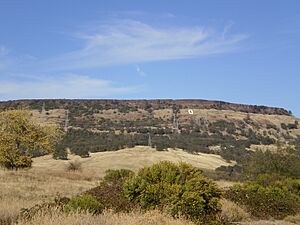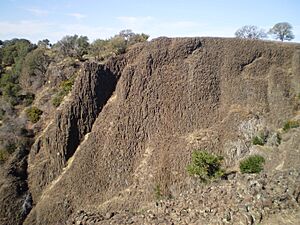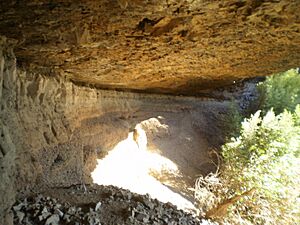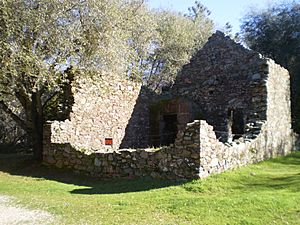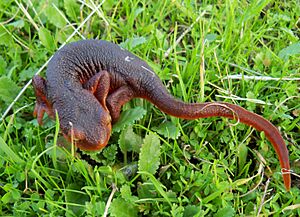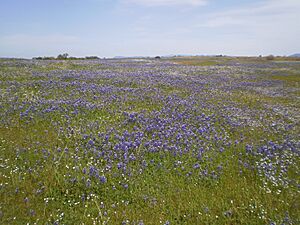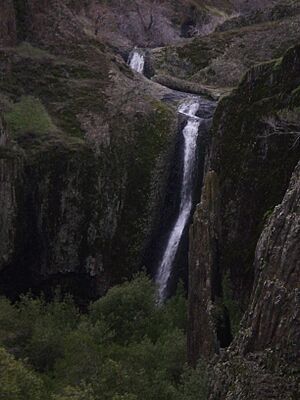Table Mountain (Butte County, California) facts for kids
North Table Mountain and South Table Mountain are two flat-topped mountains called basaltic mesas. They are located near Oroville, California, in Butte County, California. People often call them "Table Mountain" because their tops are flat like a table. Sometimes, they are even mistakenly called Table Top Mountain.
Contents
Location and Features
North Table Mountain and South Table Mountain are covered by the remains of an old lava flow from millions of years ago. This hard, black rock is called basalt. It's part of something scientists call the Lovejoy Formation.
South Table Mountain
South Table Mountain is mostly private land. It has a giant "O" on its side, which stands for the city of Oroville. This "O" was put there in 1929 by students from Oroville High School. It's made of concrete and is very big, about 87 feet long and 33 feet wide! The students wanted the "O" to remind everyone about good sportsmanship and working together. Most of the "O" and the ways to get to it are on private property.
North Table Mountain
North Table Mountain is also mostly private, but a small part of it is a special wildlife area. This area has many cool features like vernal pools (ponds that fill with water in spring and dry up in summer) and waterfalls, including Phantom Falls and Beatson Falls. There are no marked trails, so if you want to hike to the waterfalls, you have to find your own way. The best time to see the waterfalls is in winter and early spring, as they usually dry up in the summer. Remember, everything east of Cherokee Road in Morris Ravine is private property and off-limits unless you have special permission.
Coal Canyon
Coal Canyon is where Phantom Falls is located. It got its name because the rocks there look like coal, but they are actually made of basalt. Getting to the canyon and waterfall involves a difficult, steep hike downhill.
Caves
North Table Mountain has several shallow caves hidden in its basalt canyons. There are about five caves, mostly found behind large waterfalls. The biggest cave is at Phantom Falls, and the deepest one, which you have to crawl into, is at Little Phantom Falls. Both of these are in Coal Canyon. There are also smaller caves at Flag Falls and Beatson Falls, and another behind a small unnamed waterfall. These caves are made of basalt and clay. They formed over thousands of years as the waterfalls slowly wore away the rock. The caves in Coal Canyon are the easiest to reach, and the one at Phantom Falls is the most visited.
History of the Area
Cherokee
The small ghost town of Cherokee, California, is on the mountain. It's named after a small group of Cherokee Indians who settled there long ago. Today, only ruins remain, but about 20 people still live in the area.
Phantom Ranch
Phantom Ranch is what's left of an old ranch house from the late 1800s. It was used during the Gold Rush. You can see the ranch ruins when you hike to Phantom Falls. Now, only a few pieces of wood from its foundation remain.
Wildlife and Nature
Wildlife on Table Mountain
Table Mountain is home to many different animals. You might see California newts, banana slugs, various frogs, and many kinds of birds. There are also western Pacific rattlesnakes, garter snakes, and California horned lizards. Larger animals include black-tailed deer, coyotes, and even mountain lions. You'll also see domesticated cattle roaming freely. A small area called Sugarloaf Mountain is said to have peacocks, foxes, and wild turkeys.
Climate and Habitat
The mountains have two main types of natural areas: grasslands and forests. The weather is usually wet and rainy from late autumn to early spring. In the summer, it gets hot and dry.
Mining History
There's a silicon mine at the bottom of North Table Mountain. You can also find several old irrigation mines at the north end of North Table Mountain. An old mine shaft from the California Gold Rush era is located at Phantom Falls. In the late 1800s, a lot of gold was found near Cherokee using a method called hydraulic mining, but this stopped because of environmental concerns. Many good quality diamonds have also been discovered in the area.
Table Mountain in Movies
Table Mountain has been used as a filming location for movies. It appeared in Terrence Young's film The Klansman, starring O.J. Simpson, where it was used to represent scenes in Alabama. Clint Eastwood also filmed parts of his 1976 movie The Outlaw Josey Wales here. Director John Leone used the location for the Henry Fonda film The Last of the Cowboys in the same year.
Tours and Wildflowers
Guided Tours
Volunteers from the California Department of Fish and Game offer free guided tours on North Table Mountain. These tours happen on the first and third Saturdays of the month, from February to May. This is when the waterfalls are flowing and the wildflowers are blooming. Tours start from a parking lot on Cherokee Road, with two tours each day, lasting about two hours.
Spring Wildflowers
Table Mountain is most famous for its amazing display of wildflowers in the spring. The flowers usually bloom from the last two weeks of March to the first two weeks of April. This flower bloom is the most popular attraction, drawing visitors from all over Northern California. Sometimes, special photo tours are offered, which are usually announced in local newspapers and news.
Many different kinds of flowers bloom here, including lupine, frying-pan poppy, and goldfields. The California Department of Fish and Wildlife protects these flowers, so picking them is against the law. However, visitors are welcome to look at and even gently touch the flowers, as long as they don't damage them. Since there aren't many trails, it can be hard to avoid stepping on flowers in some areas. It's important to be careful while hiking to protect these delicate plants. The best flowers are often found between Fern and Phantom Falls.
Waterfalls of Table Mountain
- Beatson Falls
- Catamount Falls
- Coon Falls
- Crack Falls (also known as Crevice Falls)
- Fern Falls (also known as Ravine Falls)
- Flag Falls
- Hidden Falls
- Hollow Falls
- Little Phantom Falls
- Long Falls (also known as Ranch Falls)
- Lower Ravine Falls
- Phantom Falls (also known as Coal Canyon Falls)
- Ravine Twin Falls
- Schirmer Cascade
- Schirmer Falls
- Scott Falls
- Western Falls
There are also many smaller waterfalls that don't have names.
|


